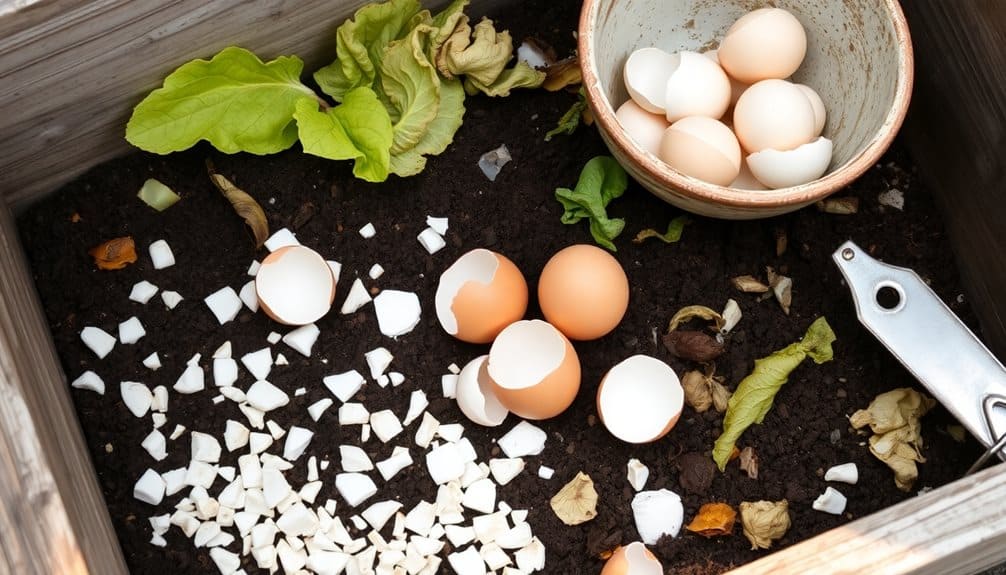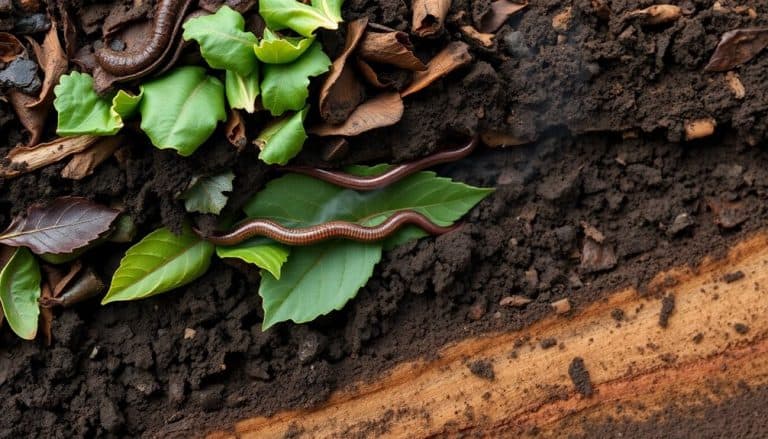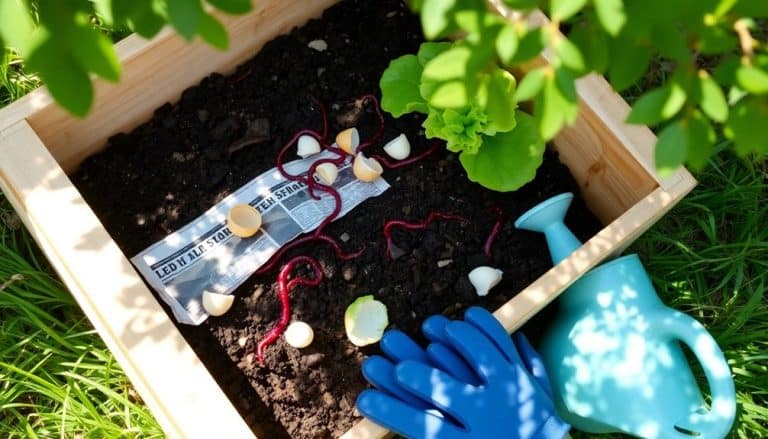This website contains affiliate links. Some products are gifted by the brand to test. As an Amazon Associate, I earn from qualifying purchases. The content on this website was created with the help of AI.
You can compost eggshells through five effective methods to enrich your garden soil with calcium. Blend shells into a fine powder using a coffee grinder for rapid decomposition, or mix crushed shells directly into your garden soil about two weeks before planting. Add powdered shells to your worm bin for calcium-enriched castings, or use the slow decomposition method by layering crushed shells under organic mulch. For acid-loving plants, combine crushed eggshells with coffee grounds in a 1:2 ratio. Each technique offers unique benefits for transforming your kitchen waste into valuable garden nutrients.
Key Takeaways
- Grind clean, dried eggshells into a fine powder using a coffee grinder or food processor for faster decomposition in compost.
- Mix powdered eggshells directly into garden soil at 4-5 shells per square foot two weeks before planting.
- Add crushed eggshells to worm bins monthly, using one tablespoon per square foot to provide calcium for worms.
- Layer crushed shells under organic mulch in soil, allowing natural weathering to release nutrients over several months.
- Combine crushed eggshells with coffee grounds in a 1:2 ratio for nutrient-rich compost ideal for acid-loving plants.
Blending Eggshells Into Fine Powder
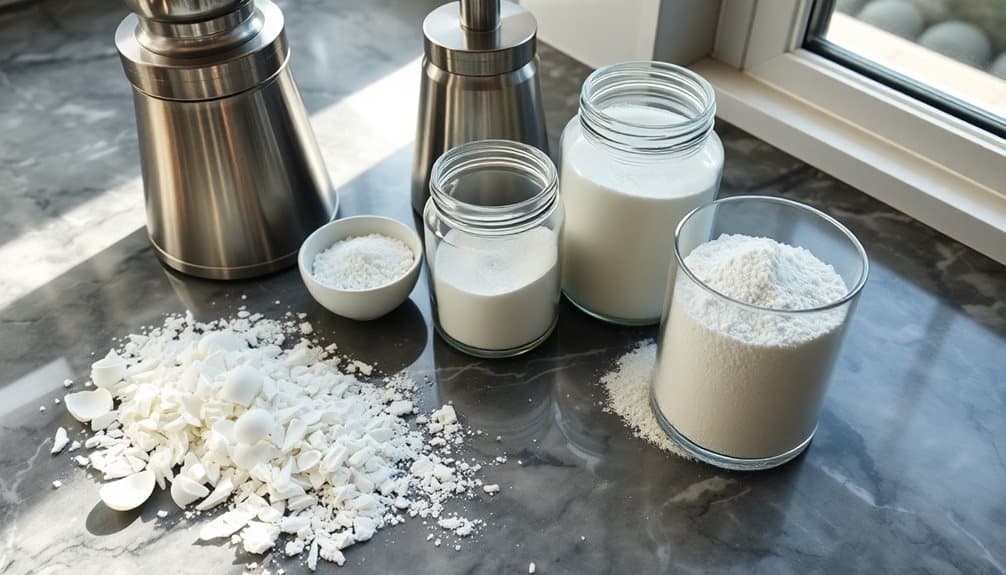
The initial step in composting eggshells involves grinding them into a fine powder to accelerate decomposition and enhance their effectiveness as a soil amendment. You’ll need to start by thoroughly cleaning the eggshells and removing any remaining egg membrane. Once cleaned, let them air dry completely for 24-48 hours to prevent mold growth.
To create the powder, you’ve got several effective methods at your disposal. You can use a coffee grinder, food processor, or high-powered blender to pulverize the shells. If you’re processing large quantities, a mortar and pestle will also work effectively. Before grinding, it’s important to break the shells into smaller pieces to prevent damage to your equipment.
For best results, you’ll want to achieve a powder consistency similar to ground coffee. The finer the powder, the more rapidly it’ll break down in your compost pile and release calcium into the soil. Store your powdered eggshells in an airtight container until you’re ready to add them to your compost. Remember to maintain a 30:1 carbon-to-nitrogen ratio in your compost pile when incorporating the calcium-rich powder.
Direct Garden Soil Incorporation

Direct incorporation of powdered eggshells into garden soil provides an immediate calcium boost for your plants without waiting for compost decomposition. You’ll need to thoroughly mix the crushed shells into the top 6-8 inches of soil, focusing on areas where you’ll be planting calcium-loving crops like tomatoes, peppers, and brassicas.
For best results, you’ll want to add your powdered eggshells to the soil about two weeks before planting. Apply approximately 4-5 crushed eggshells per square foot of garden space, ensuring even distribution. The soil’s natural acidity will help break down the calcium carbonate in the shells, making it available to your plants’ root systems.
If you’re adding eggshells to established plants, work the powder gently into the soil around the plant’s drip line, being careful not to disturb the roots. Monitor your soil’s pH levels, as eggshells can gradually increase alkalinity. You’ll find this method particularly effective in preventing blossom-end rot in tomatoes and strengthening cell walls in leafy greens. During the growing season, you can continue adding small amounts of crushed shells monthly for sustained calcium release. For optimal results, test your soil’s nutrient levels using a quick liquid test to determine if additional calcium supplementation is needed.
Worm Bin Composting

Incorporating eggshells into your worm bin provides dual benefits: calcium enrichment for your worms and grit that aids their digestion process. When adding eggshells to your vermicomposting system, you’ll need to crush them into powder or very small pieces to maximize their effectiveness. The smaller the particles, the easier it’ll be for your worms to process them.
Before adding eggshells to your worm bin, rinse them thoroughly and let them dry completely to prevent any residual egg proteins from attracting pests. You can crush them using a mortar and pestle, coffee grinder, or food processor. Sprinkle the crushed shells sparingly across the surface of your bin’s bedding material, using approximately one tablespoon per square foot of bin space.
Don’t overload your worm bin with eggshells, as they’ll decompose relatively slowly compared to other organic materials. A monthly addition is typically sufficient. The worms will gradually incorporate the calcium-rich particles into their castings, creating a mineral-enhanced vermicompost that’s particularly beneficial for plants prone to calcium deficiencies, such as tomatoes and peppers. Maintaining proper moisture protection for your worm bin is essential, as elevated designs help prevent water damage while allowing adequate drainage for healthy composting conditions.
Slow Decomposition Method
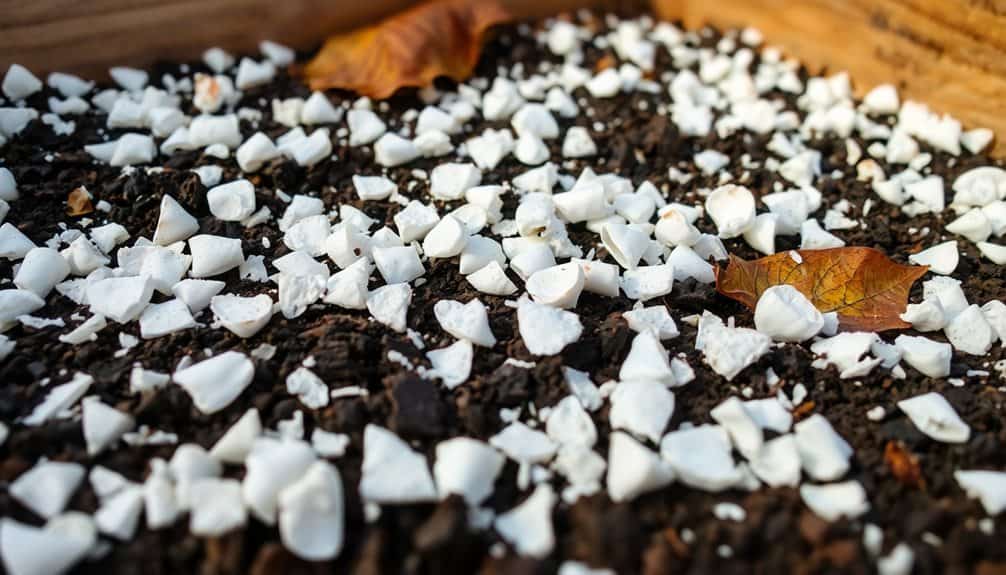
For gardeners seeking a hands-off approach, slow decomposition offers a straightforward method to break down eggshells over time. This technique relies on natural weathering processes and doesn’t require special equipment or daily maintenance. You’ll want to collect clean eggshells and crush them into smaller pieces to speed up the process, though they don’t need to be finely ground.
To implement the slow decomposition method effectively:
- Create a dedicated decomposition area in your garden by clearing a small patch of soil and loosening it to about 6 inches deep
- Spread your crushed eggshells in a thin layer across the prepared soil, ensuring they’re not clumped together
- Cover the shells with a 2-inch layer of organic mulch or leaves to keep them in place and retain moisture
You’ll notice the eggshells gradually breaking down over several months, releasing calcium and other minerals into your soil. While this method isn’t as quick as other composting techniques, it’s particularly effective for improving soil in areas where you plan to grow calcium-loving plants like tomatoes or peppers. You can continue adding shells to your decomposition area throughout the growing season. For even better results, consider supplementing your eggshell compost with compost tea to accelerate nutrient absorption in your garden soil.
Coffee Grounds Eggshell Mix
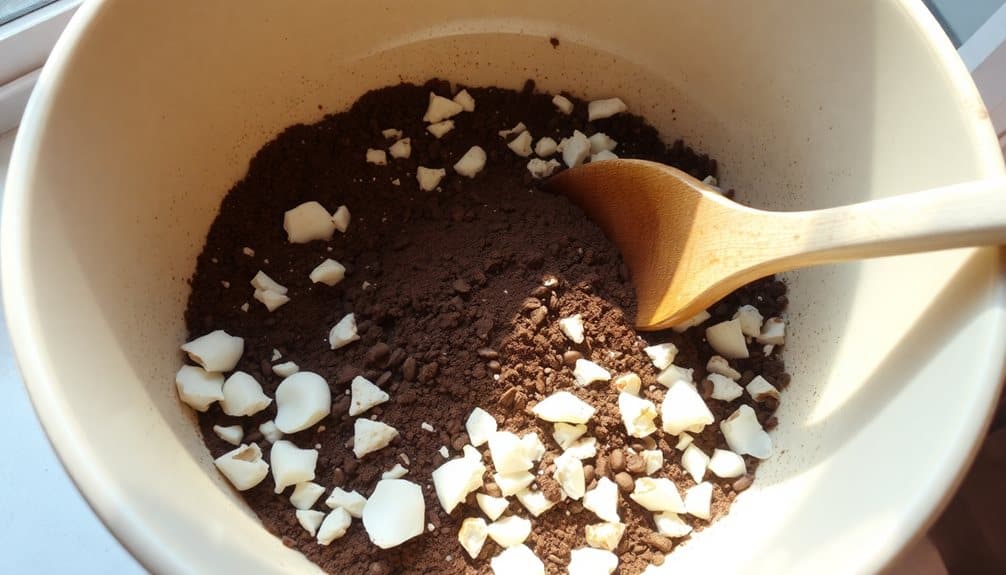
Coffee grounds and eggshells create a potent composting duo that accelerates decomposition while maximizing nutrient availability. You’ll want to collect both ingredients separately, ensuring your eggshells are thoroughly rinsed and your coffee grounds are fresh. Combine them in a 2:1 ratio of coffee grounds to crushed eggshells for ideal results.
The acidity of coffee grounds (pH 5.5-6.8) helps break down the calcium carbonate in eggshells more efficiently than traditional composting methods. You’ll need to crush your eggshells into fine pieces, ideally powder-like, before mixing them with the grounds. This increases the surface area and speeds up decomposition.
Store your coffee-eggshell mixture in a covered container with drainage holes, keeping it slightly moist but not wet. Every few days, you’ll want to stir the mixture to maintain proper aeration. The combination typically takes 3-4 months to fully decompose, producing a calcium-rich, slightly acidic compost that’s perfect for acid-loving plants like tomatoes, roses, and blueberries. You can apply this mixture directly to your soil or add it to your main compost bin as a nitrogen-rich activator.
For an enhanced growing medium, consider adding coco coir fiber to your coffee-eggshell mix for improved moisture retention and aeration.
Frequently Asked Questions
How Long Should Eggshells Be Stored Before Starting the Composting Process?
You don’t need to store eggshells for any specific time before composting them. It’s best to start processing them right after use. However, if you’re collecting them, store them in a dry container for up to one week. Don’t let them sit longer, as they can develop mold or attract pests. Crushing them immediately after they’re dry will speed up their decomposition in your compost pile.
Can Colored or Decorated Easter Eggshells Be Used for Composting?
You shouldn’t compost decorated Easter eggshells if they’ve been dyed with artificial colors or coated with non-natural materials. These chemicals can introduce harmful substances into your compost and ultimately your soil. However, if you’ve used natural dyes like beet juice, turmeric, or food-grade vegetable colorings, these eggshells are safe to compost. Always rinse and dry them thoroughly before adding to your pile.
Do Brown and White Eggshells Have Different Composting Benefits?
You won’t find significant differences between brown and white eggshells when it comes to composting benefits. Both varieties contain approximately 95% calcium carbonate and trace minerals like magnesium, phosphorus, and potassium. Their decomposition rates and soil enhancement properties are virtually identical. The color difference is purely genetic from the hen breed and doesn’t affect their nutritional or compositional value for your compost.
Should Eggshell Membranes Be Removed Before Composting?
You don’t need to remove eggshell membranes before composting. The membrane, rich in protein and collagen, actually enhances your compost’s nutritional value. While membranes take slightly longer to decompose than shells, they contain beneficial nitrogen that helps balance your compost’s carbon-to-nitrogen ratio. They’ll naturally separate from the shells during decomposition, contributing valuable organic matter and trace minerals to your finished compost.
How Many Eggshells Are Needed to Make a Meaningful Impact on Soil?
You’ll need approximately 4-6 eggshells per square foot of soil to make a noticeable impact on calcium levels and pH adjustment. For a standard garden bed of 50 square feet, you’d require about 200-300 crushed eggshells. To accelerate their effectiveness, crush them into a fine powder, as smaller particles decompose faster and release nutrients more efficiently into your soil.

